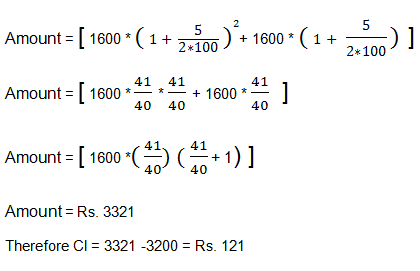1. What is the difference between the compound interests on Rs. 5000 for 11⁄2 years at 4% per annum compounded yearly and half-yearly?
1. Rs. 2.04
2. Rs. 4.80
3. Rs. 3.06
4. Rs. 8.30
Answer & Explanation Answer:- 1 Explanation :- P = 5000 R = 4% T= 3/2 2. A bank offers 5% compound interest calculated on half-yearly basis. A customer deposits Rs. 1600 each on 1st January and 1st July of a year. At the end of the year, the amount he would have gained by way of interest is: Answer & Explanation Answer:- 2 Explanation :- OR He deposited 1600 from Jan to Dec two times on half yearly basis i.e 5/2 = 2.5% 3. There is 80% increase in an amount in 8 years at simple interest. What will be the compound interest of Rs. 14,000 after 3 years at the same rate? Answer & Explanation Answer:- 4 Explanation :- Let P = Rs.100 Therefore , SI = Rs. 80 4. The compound interest on Rs. 30,000 at 7% per annum is Rs. 4347. The period (in years) is: Answer & Explanation Answer:- 2 Explanation :- Let the time be T years 5. The difference between simple and compound interests compounded annually on a certain sum of money for 2 years at 4% per annum is Re. 1. The sum is: Answer & Explanation Answer:- 4 Explanation :- Let the sum be Rs.x
A (Compounded yearly)
=> [5000*(1+4/100)(1+1/2*4/100)]
=> Rs. 5304
A (Compounded Half yearly)
=> 5000(1+2/100)^3
=> 5306.04
Difference = Rs. (5306.04 – 5304) = Rs. 2.04
1. Rs. 120
2. Rs. 121
3. Rs. 123
4. Rs. 122

So 2.5% of 1600 = 40
Therefore next time 1600+40 = 1640. 2.5% of 1640 = 41
Next amount he deposited from July – Dec
Therefore 2.5% of 1600 = 40
So total interest earn at the end of the year is 40+41+40 = 121
1. Rs.3794
2. Rs.3714
3. Rs.4612
4. Rs.4634
R = (80*100)/(100*8) = 10%
P = Rs.14000 , T = 3 years , R = 10%
Amount = P(1+R/100)^T=14000(1+10/100)^3
Amount = 14000(11/10)^3 = Rs.18634
CI = A – P = 18634 – 14000 = Rs.4634
1. 1
2. 2
3. 3
4. 3.5
Amount = 30000 + 4347 = Rs. 34347
P(1+R/100)^T = 34347
30000(1+7/100)^T = 34347
30000(107100)^T = 34347
(107/100)n = 34347/30000 = 11449/10000 = (107100)^2
Therefore T = 2 years
1. Rs.600
2. Rs.645
3. Rs.525
4. Rs.625
Compound Interest = [x(1+(4/100))^2 ] – x
CI = [ x (1 + (4/100)) ^2 ] − x = x [ ( 104/100 ) ^2 −1]
CI = x [(26/25)^2−1] = x [51/625] = (51x)/625
SI = (P*R*T)/100=( x × 4 × 2 )/100 = (2x)/25
Difference between CI & SI = Re 1.
=> (51x/625)−(2x/25) = 1
=> (51x−50x)/625 = 1
x = Rs. 625
